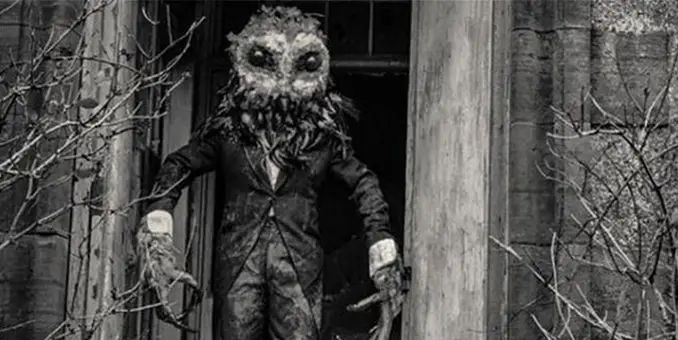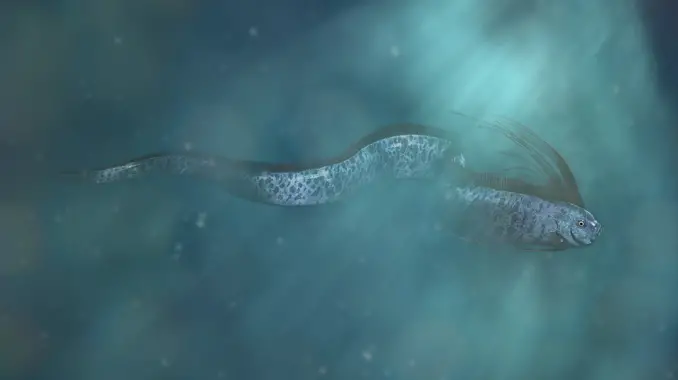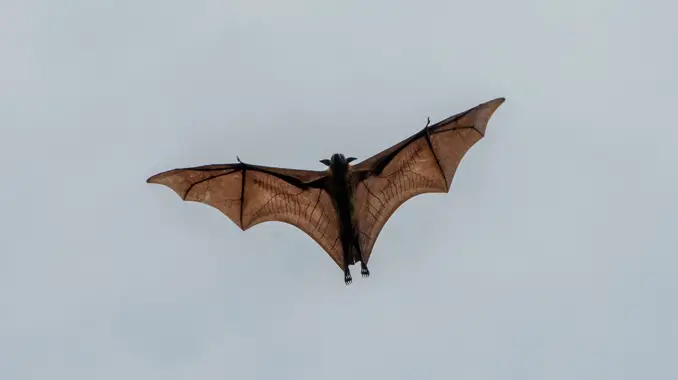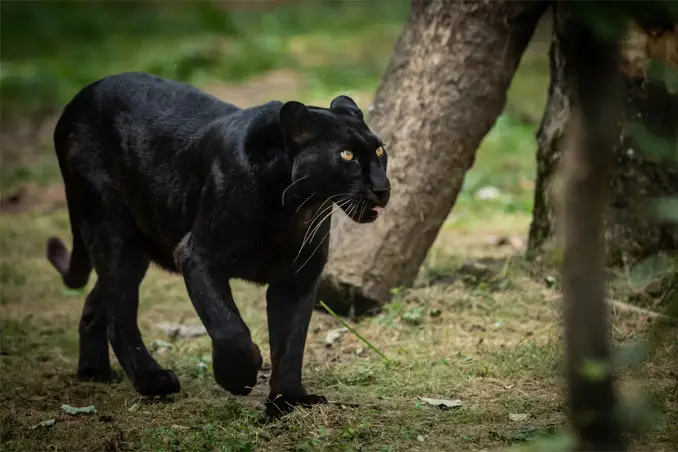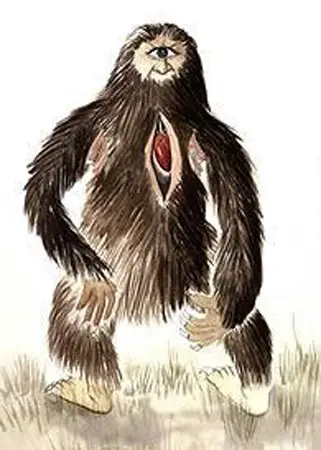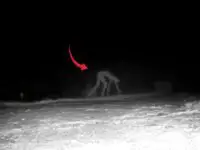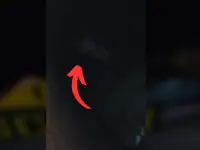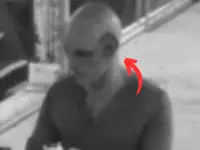From an owlman that spooked the English countryside to a beast that lurks beneath the icy Antarctic waters, these mysterious cryptids may actually exist.
7. The Cornish Owlman
Keep your ears open for the sound of flapping wings brushing against the wind if you ever find yourself wandering Cornwall after dark.
In April, 1976, two girls claim to have seen a feathered creature with man-like features hovering above the tower that overlooks the cemetery grounds at St. Mawnan and St. Stephen’s Church. One of the girls was able to produce a drawing of the unsettling creature that was part bird and part man. This creature came to be known as the Cornish Owlman.
This was not the only sighting to occur that year. Two more girls had a similar encounter while camping in July of 1976. During their trip, they claim they were confronted by a large owl with the characteristics of a man. The being had pointed ears, sharp claws and eyes that glowed black.
Since then, a number of sightings of the Cornish Owlman have been reported over the years. In more recent times, many have even claimed to have heard unsettling owl-like sounds in the area near the church.
Some believe that the sightings can be attributed to barn owls that commonly use the high church towers for nesting. However, those who claim to have seen the mysterious winged cryptid might beg to differ.
Did these witnesses really see a giant owlman? Or were they just normal, run-of-the-mill barn owls? Based on their descriptions is seems unlikely anyone would confuse the two. Let me know what you think in the comments section below.
6. The Yowie
Daily Mail
Our next cryptid takes us to the wilds of the Australian Outback.
Yowie sightings in Australia date back to the 1700’s and those who spot the mysterious creature report seeing an ape-like being that stands upright on large, flat feet.
Yowies are believed to be slightly taller than humans. Some who have encountered them report that they are shy creatures and will do anything to avoid interaction. However, others claim to have witnessed their aggressive behavior.
Yowie sightings have been reported in many areas of Australia including the Brindabella Ranges, the Acacia Hills, Bexhill, Oxley Island and the Blue Mountains.
Cryptozoologist, Rex Gilroy claims that more than 3,000 yowie sightings have been reported in recent years. Gilroy believes that sightings are actually attributed to four different species that are all sub-species of homo erectus.
Unlike many cryptids, yowies often leave physical evidence. Even footprints have been discovered at the site of several yowie encounters over the years.
5. Morgawr
Shutterstock
Once again, we return to Cornwall, England, on the trail of a sea serpent that is said to slither in the tides near Falmouth Bay.
The English Morgawr was first seen around Pendennis Point in 1975. Local fishermen report that sightings often occur when the weather and fishing conditions are poor. More recently, the creature has been spotted from the cliffs of Gerrans Bay.
Some reports claim that the Morgawr is a 60-foot long, crocodile-like creature with a large tail. Sightings of the beast have become so frequent that a stretch of the coast spanning from Rosemullion Head to Toll Point has been named “Morgawr’s Mile” by the locals.
What do you think? Could the Morgawr be an ancient sea reptile that somehow managed to escape extinction, hidden deep beneath the sea near Cornwall? Let’s hope no fisherman or swimmer ever gets close enough to find out!
4. The Ahool
Shutterstock
The Ahool is an aggressive creature that is said to stalk the jungles of Indonesia. Sightings of this mysterious cryptid predominately occur on the islands of Java and New Guinea.
The features of the Ahool may differ depending on who you ask. Some describe this creature as an over sized, ferocious bat. Others describe it as more of a winged primate that can soar through the air and lunge at prey.
In 1925, Dr. Earnest Bartels became the first person to supposedly spot an Ahool in person while exploring the thick jungles of Java. Those who say they have seen this creature often describe it as having an ape-like face with a mouth full of protruding fangs and large, dark eyes. The body of the Ahool is said to incorporate the features of several different animals. It is described as having large, over sized wings that are leathery, red and webbed, a thick coat of grey fur that makes it appear almost wolf-like and in addition, those who have gazed upon this cryptid also report that it has thick forearms and large, clawed hands.
Observers of the Ahool claim to have spotted both the male and female of the species. It is believed that female Ahools live in social groupings. They are said to be highly social creatures that raise their offspring within a community of other females. Male Ahools on the other hand, reportedly live alone as solitary animals.
Ahools are omnivores that consume whatever happens to be available in their jungle environments. They are said to be master hunters that will consume large portions of meat in one sitting should the opportunity present itself.
The stalking methods of the Ahool make this creature particularly menacing. It is said to stalk its prey through the forest by quietly swinging from branch to branch. While it is described as being able to fly, it is thought that doing so while hunting would make its stalking tactics very obvious to its prey.
Ahools are thought to follow their prey for several minutes before making their move. The moment of attack sees the Ahool suddenly drop from the tree to engulf its victim within the cruel embrace of its over sized wings. The disoriented victim is then given a fatal bite to the neck using the powerful force of the Ahool’s strong, over-sized jaw. It is said that death comes swiftly for its victims.
Little is known about the origins of the Ahool. In fact, there is even some argument regarding how to classify it if it is indeed a real creature. Some consider it to be a large bat while others believe that it could belong to the primate family.
3. The Beast of Bodmin
Shutterstock
Since 1978, sightings of a large cat-like creature have been reported by farmers across the English countryside. Known as the Beast of Bodmin, this creature is thought to have been responsible for the slaying of livestock over the years.
The details surrounding these sightings are very interesting. There is a high likelihood that sightings of the Beast of Bodmin could in fact be genuine but they may not be as fantastical or mysterious as some might think.
According to some, there is a very good chance that there are big cats roaming the English countryside. Animals that might have escaped private collections or that have been set free by overwhelmed collectors. It is also unlikely that cases like this would be reported to the authorities as owning such an animal in the United Kingdom is illegal.
Rumors have been circulating for years that an animal trainer named Mary Chipperfield may be responsible for at least one of such cases. When Chipperfield closed her zoo in Plymouth, England in 1978, sightings of large cats in the wild began shortly thereafter. Could this simply be a coincidence?
The Ministry of Agriculture, Fisheries and Food denies that these big cats exist. They do not believe the English countryside and climate could support the dietary and breeding requirements of such animals.
While many experts claim that there is no verifiable evidence to support the presence of these cats, it is well known that they are rarely spotted by humans, even in parts of the world where their numbers are abundant.
There is one more nugget of information to consider before deciding whether or not the Beast of Bodmin really does roam the English countryside. In 1995, a young boy walking along the River Fowey discovered a large cat skull with three sharp canines still intact. The skull measured 4 inches by 17 inches and researchers at the Natural History Museum in London were able to verify that the skull did indeed belong to a young male leopard.
2. The Mapinguari
Rainforest Cruises
It is rumored that in the Brazilian Amazon rain forest there lurks a creature that nobody would ever want to encounter. The mapinguari stands out among other mysterious cryptids due to its unsettling features and physical strength.
Since 2001, there have been nearly 100 reported mapinguari sightings. Farmers throughout Brazil and Paraguay often blame this creature for pulling out the tongues of their cattle before slaughtering them.
The mapinguari is described as a sloth-like animal that has several characteristics similar to a bear. It is often depicted as having long claws and red fur but what makes this creature really disturbing is its feet and legs. The mapinguari is said to walk backwards. It is also thought to have a single eye and mouth where its stomach should be. Those who have reported seeing the creature say it stands taller than an average man.
Even more foreboding than the mapinguari’s appearance is its agile nature. Those said to have fought the beast have returned from the jungle claiming that it is impervious to arrows and even bullets. The mapinguari’s weak points are supposedly its eye, stomach and mouth. However, few would ever want to verify this in person!
Tracks that are attributed to the mapinguari are commonly found in the Amazon during the dry season. These tracks are often described as similar to that of a four-toed human only they are walking backwards.
People living on the borders of the Amazon have reported hearing the disturbing cries of the mapinguari echoing through the air. Those who have heard it say it sounds like a thunderous roar crossed between high-pitched human shouting.
1. Ningen
Google Earth
With mysterious cryptids spotted all over the world, is it possible that they could also inhabit the icy waters of the World’s oceans?
Several crew members aboard research ships in the Antarctic Ocean have reported sightings of an odd, human-like creature in the chilly waters.
Known as ningen, these creatures are said to be so large that they are sometimes mistaken for structures or ships in the water. However, those who get close enough soon discover that these figures are very much alive!
Thought to have human-like faces but tentacles and tails instead of legs, the fact that several credible observers have reported sightings of these mysterious creatures has left many wondering if there is indeed an unidentified cryptid living in the Antarctic Ocean. Unfortunately, the beast has so far proved illusive as no one has been able to capture a photo of it to date. However, a 2016, Google Earth screenshot taken in the south Atlantic Ocean appears to show something that very closely fits the creature’s description.
What do you think? Does this prove the existence of the illusive ningen? Or is there another explanation for this strange image? Let me know your thoughts in the comments section below.

